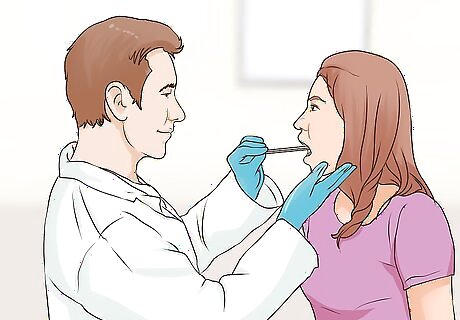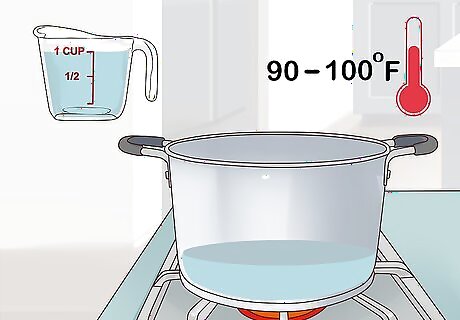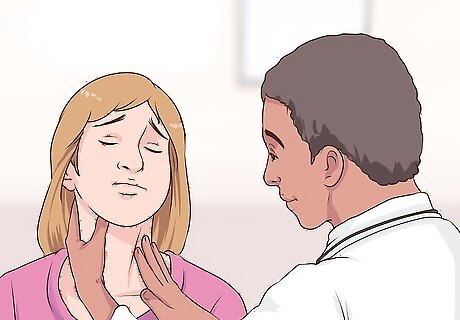
views
Resting and Hydrating Your Vocal Cords

Consult your doctor. Make sure to consult your laryngitis first before using at-home remedies to heal your vocal cords. Your laryngologist will be able to diagnose the problem and prescribe a treatment based on the severity of your specific symptoms. For mild cases, your doctor may prescribe voice rest. For moderate to severe cases, your doctor may prescribe cough depressants, antibiotics, or corticosteroids in addition to voice rest. For severe cases, your doctor may prescribe surgery to fix the issue, especially if you have nodules on your vocal cords. EXPERT TIP Amy Chapman, MA Amy Chapman, MA Voice & Speech Coach Amy Chapman MA, CCC-SLP is a vocal therapist and singing voice specialist. Amy is a licensed and board certified speech & language pathologist who has dedicated her career to helping professionals improve and optimize their voice. Amy has lectured on voice optimization, speech, vocal health, and voice rehabilitation at universities across California, including UCLA, USC, Chapman University, Cal Poly Pomona, CSUF, CSULA. Amy is trained in Lee Silverman Voice Therapy, Estill, LMRVT, and is a part of the American Speech and Hearing Association. Amy Chapman, MA Amy Chapman, MA Voice & Speech Coach If you use your voice professionally, it's a good idea to visit a laryngologist. If you have damaged vocal cords, the most important thing is to know exactly what type of damage you're dealing with. To find out, visit a laryngologist, which is an ENT with an extra fellowship in laryngology, and have them use a Rigid Stroboscopy. It's a bigger camera than the one used by a regular ENT, so it can show what's going on with your vocal cords.

Rest your voice. Depending on the severity of the damage, you should rest your voice for one to five days. To rest your voice you must avoid any kind of speaking, as well as activities that may strain your vocal cords like strenuous exercise and heavy lifting. If you must speak to a large group, consider using a microphone or megaphone. Write things down if you need to communicate to others. If you must talk, then take a 10-minute break for every 20 minutes of talking. Do not substitute whispering for talking. Whispering actually places more strain on your vocal cords than regular talking. Activities you can do while resting your voice are reading, breathing exercises, sleeping, and watching movies or TV. EXPERT TIP Amy Chapman, MA Amy Chapman, MA Voice & Speech Coach Amy Chapman MA, CCC-SLP is a vocal therapist and singing voice specialist. Amy is a licensed and board certified speech & language pathologist who has dedicated her career to helping professionals improve and optimize their voice. Amy has lectured on voice optimization, speech, vocal health, and voice rehabilitation at universities across California, including UCLA, USC, Chapman University, Cal Poly Pomona, CSUF, CSULA. Amy is trained in Lee Silverman Voice Therapy, Estill, LMRVT, and is a part of the American Speech and Hearing Association. Amy Chapman, MA Amy Chapman, MA Voice & Speech Coach Certain injuries require more rest than others. A hemorrhage on your vocal cords, which is essentially a bruise, requires strict vocal rest. If you use your voice on top of that, it can create other pathologies, such as a fibrotic mass or a cyst or a polyp. You'll need at least a week where you don't make a sound—not a cough, a hum, or even a whisper.

Drink water. Keep a water bottle with you so you can refresh your throat whenever it feels dry. Drinking water will help keep your vocal cords lubricated and your body hydrated, which can ease your symptoms and help promote healing. At the same time, you should try to avoid liquids that can prevent a speedy recovery such as alcohol, caffeine, and sugary drinks.

Get plenty of sleep. Sleep also enables your vocal cords to rest and heal. Make sure you are getting at least seven hours of sleep each night while your vocal cords are healing. Sufficient sleep helps your body heal and repair itself, which it can’t do properly while you’re awake. If you are taking a day or two off from work or school to rest your vocal cords, try not to go to bed too late.
Gargling with Water, Honey and Herbs

Heat a cup (236.6 ml) of water. In the microwave or on the stove, heat a cup of water until it is warm. Warm water is around 90 to 100 degrees Fahrenheit (32.2 to 37.8 degrees Celsius). Make sure the water is not too hot (or too cold) as this can irritate your vocal cords. For the best results, use filtered or bottled water.

Mix in two tablespoons (30 ml) of honey. Mix the honey in the warm water until it is dissolved. At this point, you can also mix in herbal extracts that have been recommended by your doctor—herbs should only be taken under the supervision of a health care practitioner. Herbs that are known to help soothe and heal your throat and vocal cords are eucalyptus, licorice, marshmallow, peppermint, and slippery elm.

Gargle for 20 seconds. Take a sip of the liquid and tilt your head back. Allow the liquid to go as far back in your throat as possible without swallowing it. Softly blow air from the back of your throat to start gargling. Make sure to spit out the liquid once you finish gargling. You can also simply sip your tea and let it coat your throat. For each session, gargle three times. Gargle every two to three hours throughout the day. Make sure to gargle before you go to bed. This way the herbs and honey can soothe and treat your vocal cords while you sleep. Honey has been used throughout history as a natural remedy, and some research shows that it has antimicrobial and anti-inflammatory properties.
Using Steam Inhalation

Heat six cups (1,419.5 ml) of water. Pour six cups of water into a pot. Place the pot on the stove and set the heat to medium-high. Once the water starts to steam or evaporate (about eight to ten minutes), turn off the heat and take the pot off the stove or kettle for immediate use. Water that is 150 degrees Fahrenheit will provide enough steam. If the water is boiling then it is too hot. Let the water cool for a minute or two before you begin the steam inhalation.

Pour the hot water in a bowl. Place a bowl on a table and pour the hot water into it. You may add 2-3 drops of herbal extracts like tea tree oil to the water, but only if you have a cold or throat infection. You can add herbal extracts like chamomile, thyme, peppermint, lemon, oregano, and clove to the water for added benefits.

Drape a towel over your head and shoulders. While you are sitting, lean over the bowl at a comfortable distance away from the steam. Place a towel over your head, shoulders, and the bowl to create an enclosure. This will trap the steam so you can breathe it in.

Breathe in the steam. Breathe normally through your nose or mouth. You only need to breathe the steam in for ten to fifteen minutes for this to be effective. Set a timer to keep track of the time. Once you have finished the steam inhalation, try not to speak for 30 minutes afterwards. This will enable your vocal cords to rest and heal after the procedure. While steam inhalation may help your vocal cords heal from minor damage, this method doesn’t take this place of antibiotics needed for more severe damage.
Healing Serious Trauma

Set up an appointment with a voice therapist. A voice therapist will help you strengthen your vocal cords through various exercises and activities. Depending on the severity of the damage, your voice therapist may also help you recover breath control while speaking, as well as regain muscle control around the damaged vocal cord to prevent abnormal tension or to protect your airways while swallowing.

Receive a bulk injection. Bulk injections are done by your laryngologist. It consists of injecting your damaged vocal cord with collagen, body fat or another approved substance to enlarge the cord. This enables your vocal cords to make closer contact when speaking. This procedure may improve your speech and reduce pain when swallowing and coughing.

Get surgery. If voice therapy and/or bulk injections do not improve your situation, then your doctor may suggest surgery. Surgery may consist of structural implants (thyroplasty), the repositioning of your vocal cords, nerve replacement (reinnervations), or a tracheotomy. Discuss the options with your doctor to see which procedure fits your individual situation and needs. Thyroplasty consists of using an implant to reposition your vocal cord. Vocal cord repositioning consists of moving your vocal cords closer together by moving tissue from the outside of your vocal box toward the inside. Reinnervation consists of replacing the damaged vocal cord with a healthy nerve from a different area of your neck. A tracheotomy consists of making an incision in your neck to create an opening to access your windpipe. A tube will be inserted in the opening to allow air to bypass the damaged vocal cords.




















Comments
0 comment